Ugh - split sideboard...
I was going over my boat looking for some spike-marks to fill and I found that one of the sideboards had started to split! Some unexpected quality time in the shop this week...
Probably that rough ice last Friday.
Cheers,
Geoff S.
US-5156
- GeoffS's blog
- Login or register to post comments
- 5451 reads
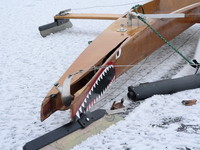
Comments
Not too bad (I think,,,)
After sanding through the varnish and epoxy the actual crack in the sidebord doesn't look bad. I can't get it to open up at all, or slide even a very thin spatula blade into it. The downside is it may be hard to get glue inside it. I'm planning to use the "warm up the board and hope it draws in the epoxy as it cools technique". I'll add a layer of glass on both sides of the sideboard, and probably a 3mm plywood doubler on the inside, so even if the crack isn't glued together the boat should hold up through the end of the season... (new hull planned over the summer).
Cheers,
Geoff S.
US-5156
First step...
First step is to warm the cracked sideboard up a bit so it will hopefully suck some epoxy into the crack as it cools down.
Next, glass on the outside and some screws...
After letting the boat get nice and warm I painted on a thick coat of warm epoxy in a narrow bead along the split. I then stuck a long piece of duct-tape over it and pounded a bit to try and force some epoxy into the split. I don't know if it helped, but the epoxy on the surface soaked in very nicely. The split shows up a bit more clearly now:

After letting the thin warm epoxy soak in a bit I turned the lamps off and kept the suface coated with epoxy for a while and let things cool off a bit. When it looked like all the epoxy that was going to soak in had, I laid a piece of bias-cut fiberglass along the side. Here's an oblique shot along the side shows the 36" long piece of glass:
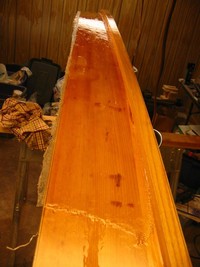
(it's actually pretty unobtrusive viewed normally)
Based on John Bushey's suggestion, I drove three screws up into the sideboard to act as "sheer-keys" and help distribute the sheer loads across the split into the rest of the board:
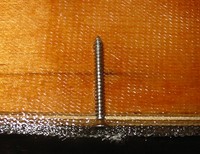
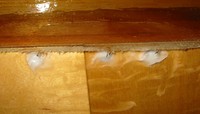
Tomorrow morning I'll trim off the excess glass and maybe put on a second coat of epoxy to level things out. Hopefully in the evening I'll be able start on the inside of the cockpit.
Morning...
The epoxy had set into the final gell state by this morning (about right for the basement temps overnight), so I was able to easily trim off the overhanging glass. Sanding wasn't happening (surface too soft), so I put the heat lamps on again and hopefully by the time I'm ready to go out the door I can sand a bit more. Worst case, I'll get to it tonite.

Post-shower update: epoxy was hard enough to sand.
Just before going out the door I carefully applied a coat of epoxy and "tipped" it with a foam brush:
The reflection in the forground is right where the glass ends. Compare with a shot from last night:
Second evening of work...
Tonite I started by stripping all the carpet-tape and varnish off the cockpit floor. Then I checked out the crack from the inside of the boat. Apparently I was at least partially sucessful in forcing some epoxy through the crack, as there was a small glob of glue inside the boat:
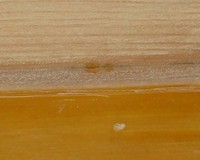
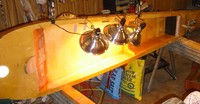
The next step was to warm up the sideboard so the epoxy would be sucked into the crack as much as possible:
With the epoxy painted on the sideboard, the crack was much clearer:
[image:1032]
The split doesn't follow the grain, so I'm wondering if it may actually be mostly a crack in the epoxy fillet where some water got in and discolored the wood a bit.
Tomorrow morning I'll add a fillet one both sides of the cockpit.
Good advice from Ken Smith on the DN BBS...
http://cerebus.winsite.com/laser/DNboard/mesgConst/967.html
Posted by: Ken Smith on February 03, 2005 at 00:22:39:
In Reply to: Sideboard "doublers" posted by Geoff Sobering on February 02, 2005 at 14:11:46:
Geoff:
The "official" plans call for plywood, inside from the bottom up about 5 inches, grain runing vertically. Two things are going on stress wise in this area. First, your weight is forward of the plank. THe mast loads are pushing down, as is your weight, and the sheet loads, plank, steering runner and fore stay are pulling up. The boat is trying to bend into a U. The bottom structure is stiff. The top of the side boards try to bend outward to let te U happen. So just forward of the plank, or sometimes just over the plank, the side boards split, begining on the inside surface, just above the inner bottom. (Adding the reinforcement as an after thought concentrates stresss in the corner).
The second thing that is going on is: your mast base is pushing the top of the mast step ball to weaather. Weight and sheet loads are holding to plank level, so the boat is torquing, trying to make your top deck face the wind, resisted by the plank connections. This makes the leeward side boardbend in and the windward side board bend outward.
When these loads combine, the split is most likely on the weather side, where the forces add. Spin-outs and other dynamic maneuvers, of course, cause you to load the side boards with but, hip or back, and with unusual local loads, as well.
So you cracked... Get glue with a strong filler into the crack. Milled glass, colloidal silica, cabosil or milled polyester are good, probably in that order. You may need to open or pry or carve or use a Zip saw to get the crack open enough. Then, if you don't have finger rails, add them (or extend them) to make the top edge of the side board stiffer. One inch by one inch are allowed, and almost nooone has them in full dimension. The boat I'll build next, copying Paul, will have vertical unidirectional glass on the inside skin from bottom to top, inside the side board forward to the first knee, or a spot about 10 inches in front of the front of the plank in its most forward position.
As you know, Geoff, I cracked a side board at the MN regatta in November. The cause for me was a spinout where I knocked the side board hard and it broke loose from the knee supporting it inside. Then it was freer to bend outboard, causing a 3 foot split. Prying, heat gun to warm the split, and then a bead of epoxy under heat gun let the stuff run like water into the crack and drip out the other side. This was followed by some thickened epoxy and some local encourgement with heat and putty knife. FOr the knee as well, a dose of filled epoxy with a generous fillet to reglue the knee.
IMHO, glass on the outside will resist a crack growing clear through the wood, but will not stop the initiation of the crack from the forces as described above. Other opinions may vary.
Ken
Fillets...
This morning I put in the fillets between the sides and cockpit floor:
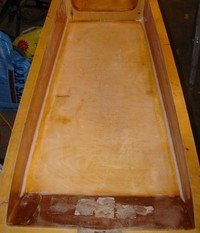
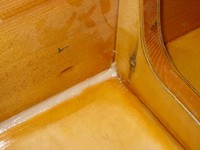
Radius is from the end of a WEST mixing-stick/spatula.
Glass on the inside...
Ken Smith provided some more spot-on advice on the DN BBS this evening:
"Don't go overboard! You boat lasted a long time without splitting the side board. Epoxy is stronger than wood. Fix the crack, call it done. [...] This repair need not be a big deal."
As soon as I got home this evening I laid in two strips of ca. 6 oz. glass tape between the cockpit floor and the sideboards:
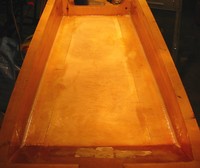
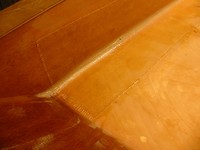
A few hours later, when the epoxy had gelled a bit I added another layer of 6 oz. glass across the cockpit floor and up about an inch onto the sides. That's curing now. Next step will be some sanding, and maybe another quick coat of epoxy. Then varnish and I'm done!
Ready for the NAs next weekend!
The split
Geoff,
I recently had a similar situation. I don't think the glass helps that much, I've even seen the cracks split the glass. So tried a different repair.... I figured the split is these is longitudinal shear, and mine showed up at the elevation of the upper floor sheet. From the bottom, I drilledpilot and clearance holes through the side board every 3-4 inches, through the crack, injected each with epoxy, then clamped the sideboard and screwed it with 3 to 4" plated screws ( sheet rock type). I figure the epoxy will get in the crack a bit, and the potted screws will act as shear keys. The clamp from the screws can hurt either.
Too much snow to try it out here.
If you do glass it, it seems like the glass should be on the bias across the crack to give shear strength.
What do you think?
John Bushey
John Bushey
Thanks!
Mine are exactly the same height (about 1/4" above the cockpit floor). I've also heard of people inserting dowels into holes for much the same reason. Luckly part of the crack extends back to the plank attachment plates, which on my boat are external and screwed into the sideboard, so the screws for that should help. I'll probably give the screws a shot.
The more I look at my boat it's not very bad, in fact it may just be cracking in the varnish from some flexing in the boat. I'm hoping the glass will help distribute the sheer loads across the grain (acting like a doubler).
Thanks again. I'm going to try and work epoxy into the crack in a few minutes.
Cheers,
Geoff S.
US-5156